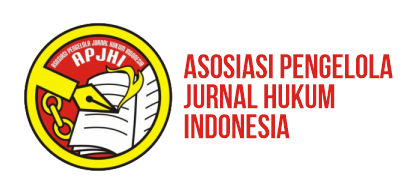Komisi Pemberantasan Korupsi sebagai Tata Konstitusional Abnormal dan Implikasi Yuridis Putusan Mahkamah Konstitusi Nomor 36/PUU-XV/2017
DOI:
https://doi.org/10.31078/jk1716Keywords:
KPK, Constitutionality, Unitary ExecutiveAbstract
This article expresses the author’s view to disagree with the existence of the KPK and its supporting Constitutional Theory. This article is based on classical model of the trias politica theory and suggests that the existence of executive bodies should conform with the prescription of unitary executive theory. According to the unitary executive theory, the president should have the power to appoint and remove any executive official exclusively. This norm is based on the status of the president as the Chief Executive. According to this notion, the KPK, as independent agency, is unconstitutional. In line with the Constitutional Court Decision No. 36/PUU-XV/2017, qualifying the KPK as executive, our abnormal constitutional order, with the existence of the KPK, should be normalized in accordance with the unitary executive theory.
References
Bailey, Jeremy D., 2007, Thomas Jefferson and Executive Power, Cambridge: Cambridge University Press.
Isra, Saldi, 2018, Pergeseran Fungsi Legislasi, Depok: RajaGrafindo Persada.
Jayawickrama, Nihal, 2002, The Judicial Application of Human Rights Law, Cambridge: Cambridge University Press.
Mochtar, Zainal Arifin, 2016, Lembaga Negara Independen: Dinamika Perkembangan dan Urgensi Penataannya Kembali Pasca-Amandemen Konstitusi, Depok: RajaGrafindo Persada.
Mulyosudarmo, Suwoto, 1997, Peralihan Kekuasaan: Kajian Teoretis dan Yuridis terhadap Pidato Nawaksara, Jakarta: Gramedia Pustaka Utama.
Sunstein, Cass R., 2017, Impeachment: A Citizen’s Guide, Cambridge-Mass.: Harvard University Press).
Tushnet, Mark, 2003, The New Constitutional Order, New Jersey: Princeton University Press.
Jurnal
Ackerman, Bruce, 2004, “The Emergency Constitution,” Yale Law Journal, Vol. 113, No. 5, h. 1029-1091.
Agustine, Oly Viana, Erlina Maria Christin Sinaga dan Rizkisyabana Yulistyaputri, 2019, “Politik Hukum Penguatan Kewenangan Komisi Pemberantasan Korupsi dalam Sistem Ketatanegaraan,” Jurnal Konstitusi, Vol. 16, No. 2, h. 313-338.
Barak, Aharon, 2002, “A Judge on Judging: The Role of a Supreme Court in a Democracy,” Harvard Law Review, Vol. 116, No. 1, h. 16-162.
Calabresi, Steven G., 2001, “The Virtues of Presidential Government: Why Professor Ackerman is Wrong to Prefer the German to the U.S. Constitution,” Constitutional Commentary, Vol. 18, No. 1, h. 51-104.
Calabresi, Steven G., dan Christopher S. Yoo, 1997, “The Unitary Executive During the First-Half Century,” Case Western Reserve Law Review, Vol. 47, No. 4, h. 1451-1561.
Calabresi, Steven G., dan Christopher S. Yoo, 2003, “The Unitary Executive During the Second-Half Century,” Harvard Journal of Law and Public Policy, Vol. 26, No. 3, h. 667-801.
Calabresi, Steven G., dan Saikrishna B. Prakash, 1994, “The President’s Power to Execute the Laws,” Yale Law Journal, Vol. 104, No. 3, h. 541-665.
Datla, Kirti, dan Richard L. Revesz, 2013, “Deconstructing Independent Agencies (And Executive Agencies),” Cornell Law Review, Vol. 98, No. 4, h. 769-843.
Koh, Harold Hongju, 2006, “Setting the World Right,” Yale Law Journal, Vol. 115, No. 9, h. 2350-2379.
Krent, Harold J., 2008, “From a Unitary Executive to a Unilateral Presidency,” Boston University Law Review, Vol. 88, No. 2, h. 523-559.
Lawson, Gary, 1994, “The Rise and Rise of the Administrative State,” Harvard Law Review, Vol. 107, No. 6, h. 1231-1254.
Lessig, Lawrence, dan Cass R. Sunstein, 1994, “The President and the Administration,” Columbia Law Review, Vol. 94, No. 1, h. 1-123.
Miller, Geoffrey P., 1986, “Independent Agencies,” The Supreme Court Review, No. 1, h. 41-97.
Prado, Mariana Mota, 2008, “The Challenges and Risks of Creating Independent Regulatory Agencies: A Cautionary Tale from Brazil,” Vanderbilt Journal of Transnational Law, Vol. 41, No. 2, h. 435-503.
Prakash, Saikrishna B., 1993, “Hail to the Chief Administrator: The Framers and the President’s Administrative Powers,” Yale Law Journal, Vol. 102, No. 4, h. 991-1017.
Prakash, Saikrishna B., 2003, “The Essential Meaning of Executive Power,” Illinois Law Review, No. 3, h. 701-820.
Prakash, Saikrishna B., 2008, “A Taxonomy of Presidential Powers,” Boston University Law Review, Vol. 88, No. 2, h. 327-340.
Strauss, Peter L., 1984, “The Place of Agencies in Government: Separation of Powers and the Fourth Branch,” Columbia Law Review, Vol. 84, No. 3, h. 573-669.
Yoo, Christopher S., Steven G. Calabresi dan Laurence D. Nee, 2004, “The Unitary Executive During the Third-Half Century, 1889-1945,” Notre Dame Law Review, Vol. 80, No. 1, h. 1-109.
Yoo, Christopher S., Steven G. Calabresi dan Anthony J. Colangelo, 2005, “The Unitary Executive in the Modern Era, 1945-2004,” Iowa Law Review, Vol. 90, No. 2, h. 601-731.
Yoo, John, 2009, “Unitary, Executive, or Both?,” University of Chicago Law Review, Vol. 76, No. 4, h. 1935-2018.
Downloads
Published
How to Cite
Issue
Section
License
Authors who publish with this journal agree to the following terms:
- Copyright of the published articles will be transferred to the journal as the publisher of the manuscripts. Therefore, the author confirms that the copyright has been managed by the publisher.
- The publisher of Jurnal Konstitusi is The Registrar and Secretariat General of the Constitutional Court of the Republic of Indonesia.
- The copyright follows Creative Commons Attribution-NonCommercial-ShareAlike 4.0 International License: This license allows reusers to distribute, remix, adapt, and build upon the material in any medium or format for noncommercial purposes only, and only so long as attribution is given to the creator. If you remix, adapt, or build upon the material, you must license the modified material under identical terms.

















